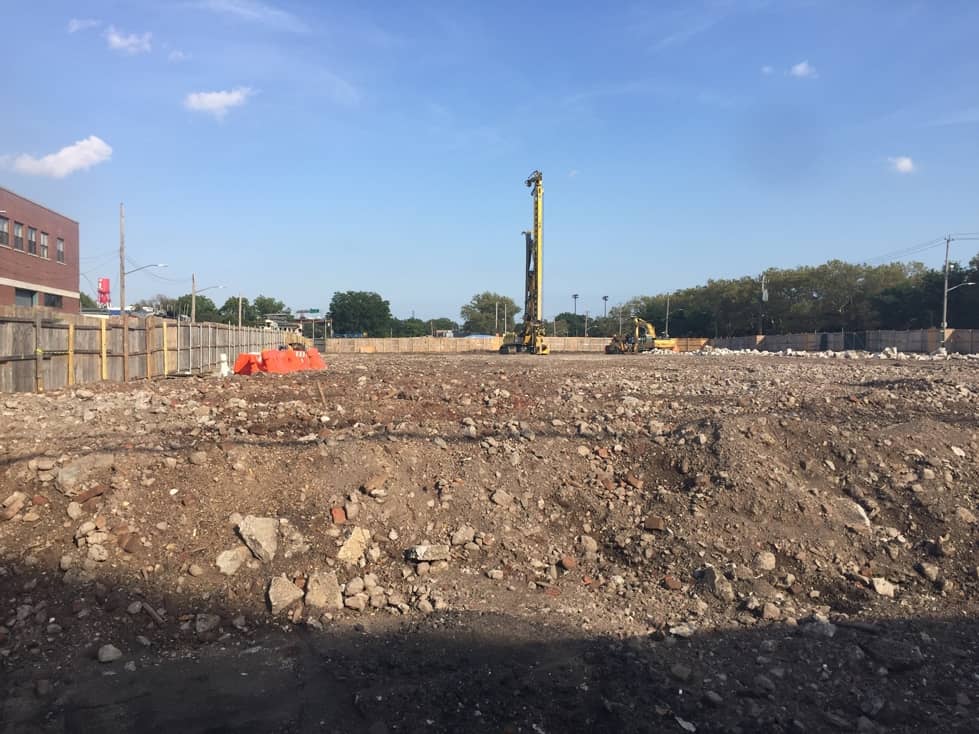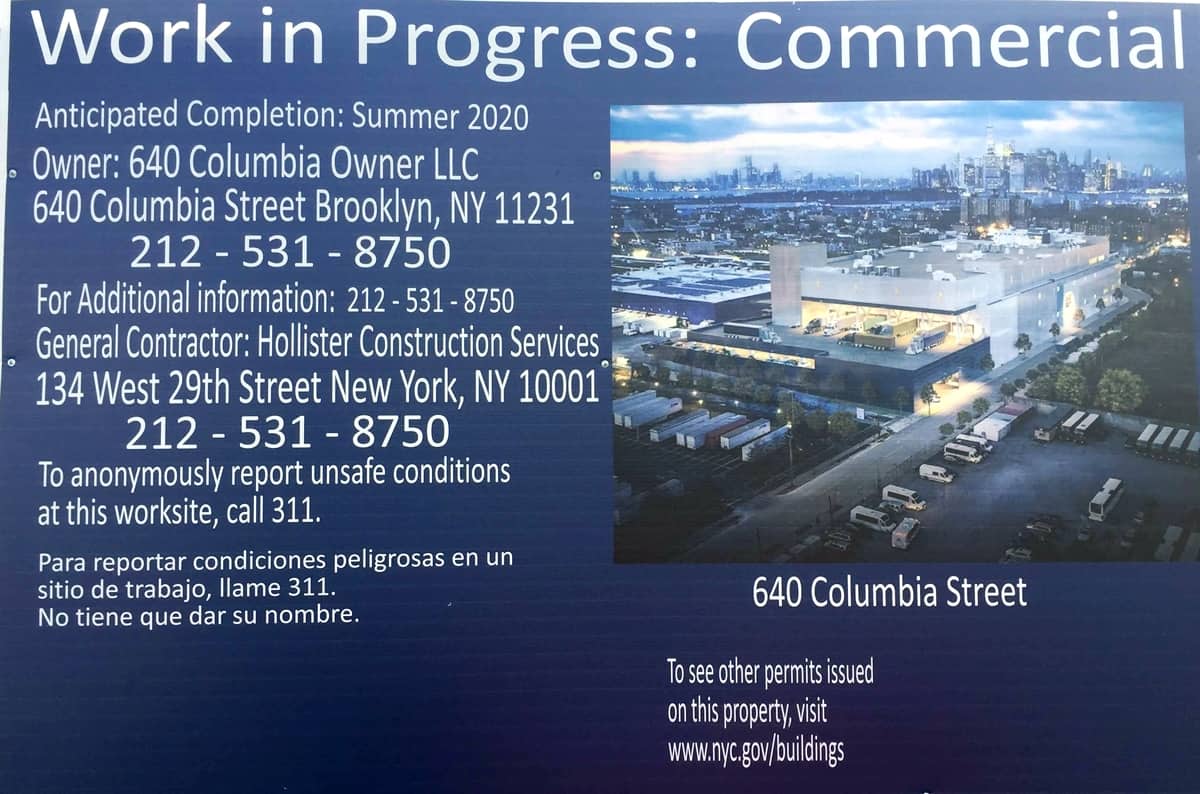The trucks are coming, and Red Hook may not be ready for them. The good news is that the city could help, but it would require serious action by the City Planning Commission (CPC) and City Council.
The increasing popularity of e-commerce, led by Amazon, has generated a new industry, “last-mile distribution,” which seeks to resolve the challenges that sellers face in transporting huge volumes of goods to customers without a brick-and-mortar retail intermediary. Same-day delivery expectations have forced merchants to move the final stages of their exurban supply chains closer to where the online shoppers live, prompting the construction of fulfillment centers (operated by “third-party logistics providers”) in Brooklyn and Queens.

Red Hook is a prime destination, thanks to its acres of disused waterfront property in manufacturing zones just a couple miles from Manhattan. DH Property Holdings has begun construction on last-mile distribution centers at 55 Bay Street (82,000 square feet) and 640 Columbia Street (336,000 square feet).
In May, UPS tore down the historic Lidgerwood Building near Valentino Pier to make way for a 1.2-million-square-foot last-mile distribution center. Earlier in the year, Thor Equities embraced the same trend, announcing that it had dropped its ambitions to build an office park at 280 Richards Street, which could accommodate an Amazon-style fulfillment center even larger than the planned UPS facility. For many Red Hookers, these are positive developments.
Not long ago, a redevelopment scheme floated by AECOM and Governor Cuomo had residents worried that towers of luxury condos would soon line the South Brooklyn waterfront and forever change the character of the blue-collar area. But councilman Carlos Menchaca has resisted residential rezoning proposals, and vacant industrial parcels are attracting new tenants likely to provide jobs to people in the Red Hook Houses. In particular, UPS – the largest single employer of the International Brotherhood of the Teamsters – boasts above-average labor standards and fair hiring practices.
At the same time, homeowners at the Red Hook Civic Association routinely bemoan the incoming invasion of trucks in the area. For buildings in Red Hook, New York City’s post-Sandy resiliency standards discourage most ground floor uses except for parking, which no longer counts against the structure’s total floor area in a flood zone, and this regulation already has spurred the construction of smaller trucking facilities in the area. By some accounts, Red Hook’s historic wood houses shake as the vehicles rumble past, and asthmatic children cower in fear when it comes time to cross the street.
It’s easy to dismiss these concerns as NIMBYism. But Red Hook, which as one of Brooklyn’s poorest communities hosted 22 waste transfer stations (a wildly disproportionate number and an obvious example of environmental racism) before residents fought them off, has a right to some wariness regarding plans that would unfairly concentrate unappealing or unwholesome land uses on its civically neglected peninsula beyond the Gowanus Expressway. No one knows exactly how many trucks will visit the new UPS facility each day, but the land’s buildable square footage matches exactly that of the company’s new regional hub in Atlanta, which can dispatch more than 280 trucks at a time. (The total acreage of the Atlanta site, however, exceeds that of the Red Hook location, giving them much larger parking areas.)
Insofar as we’ve accepted a retail model that, by standard practice, whenever someone wants to buy a box of toothpicks, immediately dispatches a truck to deliver those toothpicks directly to the buyer’s doorstep instead of asking him to walk a few blocks to a store, last-mile distribution centers must exist. But as a matter of city planning, it’d be best if they weren’t all bunched up in one corner of the city, clogging the streets and subjecting nearby residents to unusual levels of air and noise pollution.
All of the planned last-mile distribution centers in Red Hook will be built as-of-right (i.e., in compliance with the existing zoning), which means they don’t need approval from the local councilman or an environmental impact statement. Last-mile distribution presents particularly intense impacts, but planners as yet have few tools to guide its development in New York City.
That’s why the CPC should create a special use permit for last-mile distribution. According to New York State law, a special use permit is “an authorization of a particular land use which is permitted in a zoning ordinance or local law, subject to requirements imposed by such zoning ordinance or local law to assure that the proposed use is in harmony with such zoning ordinance or local law and will not adversely affect the neighborhood if such requirements are met.”
The purpose of zoning, when it’s working right, is to create a functional, orderly cityscape that serves all the diverse needs of the public without creating incompatible neighbors. To this end, planners attempt to determine which types of buildings – houses, factories, hospitals – sit easily side-by-side and which don’t, and they break the city up into zones, each of which allows particular uses. They can run into trouble, however, when new uses emerge, and the zoning laws don’t adjust to recognize them.
Shipping goods is nothing new, but last-mile distribution, as it currently exists, is a fresh phenomenon – it dates roughly to the introduction of Amazon Prime two-day shipping. When a developer builds a last-mile distribution center, the New York City Department of Buildings classifies it as a warehouse, which is sort of right but also overlooks certain differences between the storehouses of yesteryear and today’s high-powered fulfillment centers.
Whereas warehouses can accommodate the long-term storage of goods, e-commerce fulfillment centers are in a constant state of turnover. The reason is that warehouses don’t serve external customers – they facilitate transfers among manufacturers, wholesalers, and retailers, which buy in bulk. Meanwhile, all the tiny individual purchases by Amazon Prime customers travel through fulfillment centers: the number of shipments per hour – all to different addresses – is unparalleled.
In order to plan more effectively, the CPC could study last-mile distribution patterns in order to distill more precisely the differences between warehouses and fulfillment centers and then could create a separate land use classification for the latter within the New York City Zoning Resolution.Warehouses exist in C8, M1, M2, and M3 zones, which means any manufacturing zone and even some commercial areas; however, for fulfillment centers, the CPC could, within the Zoning Resolution, set out the terms of a special use permit that would give the city an additional measure of control over their placement.
This mechanism might have to differ slightly from the special permits described within the current Zoning Resolution, which allow the CPC or the Board of Standards and Appeals to grant exceptions for the construction of certain buildings outside the zones to which they normally belong, given that they comply with particular rules – like hotels in manufacturing districts, student dormitories in residential districts, and sewage disposal plants in commercial districts. The problem with last-mile distribution is not that it’s trying to enter the wrong sorts of areas (all of the facilities in Red Hook will be in manufacturing zones) or that it should be automatically prohibited from any of the zones that currently allow it – it’s that it carries with it concerns that call for special consideration in any area.
For this reason, a zoning amendment designed to address last-mile distribution might, somewhat oddly, resemble the section of the Resolution that determines “Special Provisions for Adult Establishments,” like strip clubs and porn shops. Adult establishments can exist in a multitude of commercial zones or even, depending on the type of building, in a manufacturing zone. But wherever they are, they must abide by certain rules, which vary a bit from zone to zone but in each case ensure that no such business should come within 500 feet of a school, a house of worship, or a residential area.
In states that legalized recreational cannabis, planners recognized an emerging use category – dispensaries – and amended city zoning ordinances to establish similar provisions, as well as to create buffers between the dispensaries themselves to make sure that there weren’t multiple pot shops in the same commercial strip. In that case, they were catering to a certain kind of moralism, but the same buffer mechanism could be useful for other purposes: for instance, to limit the number of last-mile distribution centers within a particular square mileage so as to spread traffic more evenly.
The special use permit for last-mile distribution would not hand over the right to build distribution centers to the discretion of capricious city administrators. It would not force UPS to stand before City Council for a ULURP. Instead, it would create a fair, consistent formula – factoring in questions of size, utilization, and proximity to residences, schools, and other distribution centers, possibly with particular guidelines for each zone in which such structures might be built – that would grant companies permission to build in each case where they’ve met all the conditions. The terms of the permit would have to be crafted with great care so as not to prevent investment in useful infrastructure where it’s likely to cause minimal harm.
It would, however, force last-mile distributors to submit detailed applications for review by the CPC or the Board of Standards and Appeals, and if the process works as it should, it might prevent Red Hook from turning into Maximum Overdrive. All changes to the Zoning Resolution require some political capital – approval not only by the CPC but also by City Council – but good planning is worth the fight. If we don’t act now, it might soon be too late for the streets of Red Hook.









